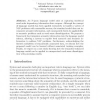Free Online Productivity Tools
i2Speak
i2Symbol
i2OCR
iTex2Img
iWeb2Print
iWeb2Shot
i2Type
iPdf2Split
iPdf2Merge
i2Bopomofo
i2Arabic
i2Style
i2Image
i2PDF
iLatex2Rtf
Sci2ools
CICLING
2008
Springer
2008
Springer
A Semantics-Enhanced Language Model for Unsupervised Word Sense Disambiguation
An N-gram language model aims at capturing statistical word order dependency information from corpora. Although the concept of language models has been applied extensively to handle a variety of NLP problems with reasonable success, the standard model does not incorporate semantic information, and consequently limits its applicability to semantic problems such as word sense disambiguation. We propose a framework that integrates semantic information into the language model schema, allowing a system to exploit both syntactic and semantic information to address NLP problems. Furthermore, acknowledging the limited availability of semantically annotated data, we discuss how the proposed model can be learned without annotated training examples. Finally, we report on a case study showing how the semantics-enhanced language model can be applied to unsupervised word sense disambiguation with promising results.
CICLING 2008 | Language Model | Natural Language Processing | Semantic Information | Word Sense Disambiguation |
| Added | 12 Oct 2010 |
| Updated | 12 Oct 2010 |
| Type | Conference |
| Year | 2008 |
| Where | CICLING |
| Authors | Shou-de Lin, Karin Verspoor |
Comments (0)

